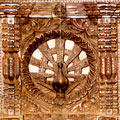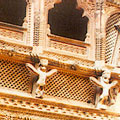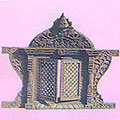The profusion of carved wood in the old Newar towns in the Kathmandu Valley is so great that it almost defies description. Every traditional townhouse, every temple and monastery, and every palace, offers examples of an enormous variety of carved doors, windows, struts, pillars, toranas, and so on – many of these are unique in themselves. Wood was the medium through which the artistic exuberance of the Newar craftsperson was expressed to the fullest. According to tradition the valley of Kathmandu derives it name from kastamandapa meaning a temple built from wood of a single tree which it is believed was constructed some 800 years ago.
Until the comparatively recent past, much of Nepal remained richly forested and timber was readily available. It was therefore used extensively in local architecture, much like it was in the architecture of Kashmir, of the Himalayan districts of India and, further east, of Bhutan. Wood was used both structurally and for the decoration of buildings in the Kathmandu Valley; as time went on, its decorative function seems to have outstripped its structural role. Thus, although doors and windows are obviously necessary for access to a building and to provide both light and air, they increasingly became more like vehicle for the artistic endeavours of the woodcarver, to the extent that many of Nepal’s richly carved temple doors were never meant to be opened, and that there are windows that serve to illuminate upper storeys where no human being has ever ventured, or ever will.
The Newars have a rich vocabulary, particular to them, to describe the tools, components, decorative motifs, and patterns used in woodcarving – many of the Newars’ techniques and compositions follow the stipulations of medieval Vastuhastra texts such as the Manisara. Typically, the components of a wooden artefact such as a window frame or a door are assembled without the use of metal nails or glue, although wooden pins are used on occasion.
For the exterior of the buildings the craftsmen use a hard wood which is not easily destroyed by sun, wind or rain. Their first choice is therefore the hard sal wood that is seasoned for several years before it can be used. Chanp, pine, cedar, sissoo varieties of wood are used for carving objects that are not exposed to the elements. The sal wood that is used for exterior decoration requires the carvers to put in extra hours of work and exercise great care while working – the carvings on such wood is a far more painstaking job. However if there is proper upkeep and care the wooden doors and windows can last for many decades.
DETAILS OF DOORS & WINDOWS
Doors and windows, both functional and purely decorative, are often the most lavishly decorated elements of a traditional Newar building. It is not only the frames that were decorated – because glass was not used in Nepal until quite recently, it was necessary to find a way to block out the elements and the prying eyes of passers-by while admitting light, and the solution was a wooden latticed screen. This form probably developed from essentially utilitarian considerations sometime before the 12th century, but by the middle of the Malla period it had become immensely diverse.
The general term for a latticed Newar window is tiki-jhya or tika-jhya, ‘jhya’ being the Newari word for ‘window’, which has entered Nepali as ‘jhyal’. Within this general category there are specific terms for particular varieties of tikijhya. For instance:

- gah-jhyas, yaku-jhyas, baku-jhyas, and chaku-jyas are all different kinds of blind windows
- gua-jhya is a round window
- chapa-jhya is a heavy-framed multiple window
- lun-jhya is a gilded window
- gumbaj-jhya is an arched window that may be flush with the wall or projecting and have single or several openings.
Windows at the ground and first-storey level are unlikely to be openable; an openable window in a building is almost always on the uppermost storey. Multiple bay windows, designated for the occupants of a building (whether mortals or immortals) to look out and to breathe in the air, are always on the top floor.
An interesting characteristic of the carved windows is that they are not all meant for looking out. Some of them are designed solely as embellishment. For the Nepalese windows represent more than just a means of ventilation – it is believed that the religious icons carved on the windows offer protection from calamities and bring peace and prosperity into the home. While in some windows the central shutter can be opened to peer out, most of the window shutters have lattice structures of various designs that are fixed. Balcony windows are very popular and are so called as they have balconies on the inner side and one can peer out from these windows.


- There exists a rich heritage of design in the carving of the windows. The most popular motifs and designs include the lotus, chariot, peacock and sun window motifs, the corner and balcony window, circular window, the mesh window, the window with a bow frame, an assembly of three to five windows, the halved window and others. There are also many variations in the placement of the windows, for instance a single inset window can be sandwiched in between multiple windows; windows can also be artistically placed under the roof of the temple. The arched panel of the window and the toran or decorated panel fixed at the top, also have marvellous wood carvings.
- The door frames are carved with images that symbolise good fortune, peace and happiness. They include floral designs, images of gods and goddesses, carvings of the eyes of the Buddha, designs of the traditional religious water pot (kalash), fish etc. The doors consist of either a single or double shutter and are made of soft wood when they are not exposed to the sun or rain and of hard wood if there is exposure.

